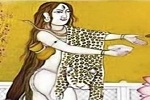
Lalleshwari Devi
Kashmir is the land of mystics. Named after the great Maharshi Kashyap, Kashmir has cradled many spiritual traditions, and especially the Shaiva traditions. Among the many great souls who have blessed the Sharda Desh with their presence, Lalleshwari Devi is one of the foremost names. She is one of those few exemplary women who left their worldly lives in search of the Ultimate, and achieved the union with the Divine, thus becoming a source of inspirations for all those on the spiritual quest.
Life
Lalleshwari Devi is also known as Lalla Yogini, Lal Ded (Ded means mother), Lalla Arifa (Arifa means lover of God), LaliSri etc. Lalla simply means seeker or darling. It is generally considered that Lalleshwari Devi was born in 1320 in a Brahmin Family in Pandrenthan in Kashmir. Lalleshwari Devi’s final departure from the world was as miraculous as her life was. Her mortal body became like light and then vanished. It is said that this happened in Anantnag in 1392. It is not clear when she was initiated into the Shaiv tradition, but it is known with fair surety that her Guru was Siddha Srikant. Swami Paramanand Tirth is also said to have guided her.
Various oral traditions mention that she was married off at an early age of twelve years to Nica Bhatta from Pampore. After marriage, she was rechristened Padmavati. Lalli had been a seeker since birth. Her inward oriented nature and desire for solitude did not sit well with her husband and mother-in-law. Stories of her life mention that the mother-in-law would put a stone on her plate and cover it with rice so it looked like a plateful of food and Lalli went hungry. But she never complained.
Renunciation
Lalli fetched water from the river near her house daily. Across the river was the Nat Keshav Bhairav temple where she spent some time every day. One day, she returned home later than usual. What happened next revealed Lalli’s high levels of spiritual development. Her husband took to anger and flung the water pot she was carrying on the ground. The pot had shattered, yet the water in it retained its shape, and did not spill. Legend has it Lalli calmly scooped the water in another utensil and from the water leftover at this very spot a pond was created. It is now known as the Lalla trag (pond).
After this incident, Lalli completely renounced the worldly life. She wandered in the wilderness and intensified her practices to the utmost. Soon enough, people began to recognize her stature.
Annihilation of ‘I’
Lalleshwari Devi is a true representation of the epitome of sainthood. She was a sky clad saint. When asked does she not feel embarrassed in front of men, she replied- But I see no men, there is only Shiva. The following story shows her state of equanimity to praise and criticism. Once some truants were teasing her when a cloth merchant offered her some clothes to cover herself. She took two long pieces of cloth from him and went her way. When someone praised her or bowed to her she’d tie a knot in one cloth, and when somebody taunted her or criticized her she tied a knot in the other cloth. Towards evening, she went back to the merchant and asked him to weigh the two clothes and tell her which was heavier. Thus, she demonstrated that just as the knots made no difference to the weight of the clothes, criticism and praise meant nothing. Such inner state is attainable only when the sense of ‘I’ has been completely demolished, something even the advanced yogis fall prey to.
Guru Lalleshwari
Lalleshwari Devi’s advent in Kashmir was at a time when the onslaught of Islam was peaking. Her use of Kashmiri language to convey the Shaivite teachings ensured that they were absorbed into the psyche of the masses. She showed path to many other remarkable saints of Kashmir, the most well known of whom are Nand Rishi and Rupa Bhawani. When Nand Rishi was born, he refused to partake his mother’s milk. Lalleshwari Devi appeared on the scene and breastfed the baby Nand. Nand Rishi has referred to her exalted position on several occasions. Similarly, another Shaiv saint of Kashmir Bhawani Devi refers to Lalleshwari as her first guru. Even after the miraculous end of her mortal body, Lalleshwari Devi is known to have manifested herself on several occasions to true seekers who need and seek her guidance.
Lal Vakh
Lalleshwari Devi’s teachings are recorded in the form of her mystic poetry which is known as Vakh or Lal Vakh or Vatsun which are variations of the word ‘Vachan’ which means utterance. Almost 300 vachans composed in Kashmiri language are attributed to Lalleshwari Devi. These are the earliest compositions in the language. Some of her Vachana are mentioned here-
“Having crossed the six forests, I awakened the moon , By controlling my breath I appeased nature With the fire of love, I scorched my heart And in this way I found Shankara.”
“One who sees no difference between oneself and others Who regards the day and the night as the same Whose mind is free of all duality S/he alone has the vision of Shiva, the lord of the gods. You will see different people in this theatre of the world Tolerate this difference and you will find happiness If you root out anger, resentment and ill-will Then alone you will see Shiva’s face.”
“Through the door to the garden of my mind I, Lalla, entered and lo what bliss! I saw Shiva in communion with Shakti There I became immersed in the lake of nectar Now what can Death do unto me? For I shall be dead even though alive!”

